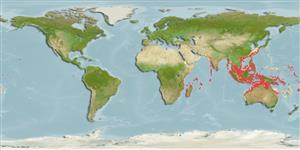>
Carangiformes (Jacks) >
Carangidae (Jacks and pompanos) > Caranginae
Etymology: Caranx: French, carangue, the name of a Caribbean fish; 1836 (Ref. 45335).
More on author: Cuvier.
Environment: milieu / climate zone / depth range / distribution range
Ecologia
marino associati a barriera corallina; distribuzione batimetrica 30 - 120 m (Ref. 12260). Tropical; 35°N - 31°S, 32°E - 172°W
Indo-West Pacific: Zanzibar (Tanzania) to Durban (South Africa), Madagascar and Sri Lanka; north to Okinawa, Ryukyus, south to the Arafura Sea (Ref. 9819), Australia and Fiji. Distribution in the Indian Ocean not well established.
Size / Peso / Age
Maturity: Lm ? range ? - ? cm
Max length : 80.0 cm TL maschio/sesso non determinato; (Ref. 3197); common length : 50.0 cm TL maschio/sesso non determinato; (Ref. 3280); peso massimo pubblicato: 7.2 kg (Ref. 40637)
Spine dorsali (totale) : 9; Raggi dorsali molli (totale) : 20 - 22; Spine anali: 3; Raggi anali molli: 16 - 18.
Adults inhabit coastal waters, near coral reefs and rocks. They feed on fish and crustaceans (Ref. 5213). Solitary or small groups are found in vicinity of reefs (Ref. 90102).
Life cycle and mating behavior
Maturities | Riproduzione | Spawnings | Egg(s) | Fecundities | Larve
Paxton, J.R., D.F. Hoese, G.R. Allen and J.E. Hanley, 1989. Pisces. Petromyzontidae to Carangidae. Zoological Catalogue of Australia, Vol. 7. Australian Government Publishing Service, Canberra, 665 p. (Ref. 7300)
IUCN Red List Status (Ref. 130435)
Threat to humans
Harmless
Human uses
Pesca: scarso interesse commerciale; Pesce da pesca sportiva: si
Strumenti
Special reports
Download XML
Fonti Internet
Estimates based on models
Preferred temperature (Ref.
123201): 22.5 - 28.3, mean 27 °C (based on 580 cells).
Phylogenetic diversity index (Ref.
82804): PD
50 = 0.5000 [Uniqueness, from 0.5 = low to 2.0 = high].
Bayesian length-weight: a=0.01380 (0.00771 - 0.02471), b=2.99 (2.84 - 3.14), in cm total length, based on LWR estimates for this species & Genus-body shape (Ref.
93245).
Trophic level (Ref.
69278): 4.1 ±0.68 se; based on food items.
Generation time: 3.8 ( na - na) years. Estimated as median ln(3)/K based on 1
growth studies.
Resilienza (Ref.
120179): Medio, tempo minimo di raddoppiamento della popolazione 1.4 - 4.4 anni (Preliminary K or Fecundity.).
Fishing Vulnerability (Ref.
59153): Moderate vulnerability (38 of 100).
Nutrients (Ref.
124155): Calcium = 21.2 [8.2, 42.2] mg/100g; Iron = 0.329 [0.169, 0.663] mg/100g; Protein = 20.1 [17.9, 22.5] %; Omega3 = 0.132 [0.077, 0.227] g/100g; Selenium = 52.3 [24.0, 109.9] μg/100g; VitaminA = 46.5 [16.8, 118.3] μg/100g; Zinc = 0.491 [0.332, 0.745] mg/100g (wet weight);
